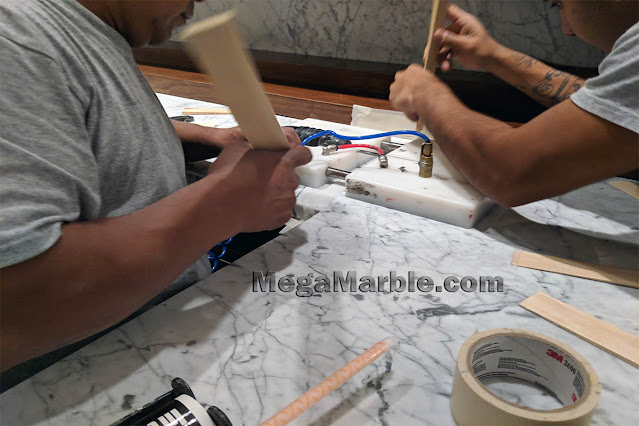Seaming/Joint in Granite, Marble, or Quartz Countertops
Kitchen countertops install with an almost invisible seam
There is nothing that can distract one from the overall beauty of a new countertop like a poorly fabricated and installed seam. Actually, the fear of poor seaming is one of the main reasons why most customers want to avoid seams in their countertops.
For most kitchen countertops made of natural stones, seams (places where two individual stones are joined together) are practically unavoidable. That is sometimes hard to understand for customers as all they see is the huge piece of stone their countertop will be made from and obviously wonder why it can’t simply be cut into one piece.
Actually, it can, but only for smaller surfaces, like a bathroom vanity top, and obviously, larger kitchen countertops present more of a challenge. That being said, let’s go over why seams are often necessary and how good stone fabricators can minimize their appearance.
Reasons for Seaming
Actually, a large number of factors can impact seam placement. In the case of granite, slabs generally come in many different shapes and sizes. The sizes of the slabs can range from 110” to over 130” inches in length and from 55” to 80” inches in width.
And of course, if the length of a countertop is longer than that of the slab it will require a seam, and that is our first reason.
Secondly, some types of granite have distinct veining also known as “flow”. In the case of marble, veining is an integral part of the stone and is even one of the main beautifying agents. Back to the reason for seaming, in case two slabs have to be joined, seaming becomes necessary as the patterns need to be aligned for visual continuity and aesthetics.
How is seam-sealed?
As mentioned above, the two pieces of stone will be joined and then filled with an epoxy resin, which is colored to match the stone.
Depending on the stone, the fabricator may opt to use a clear resin or will use multiple colors to try to make the seam as invisible as possible. Generally, a seam should be less than 1/16th of an inch wide, and special machinery will be used to join and hold the two pieces to make the seam as narrow and tight as possible.
Overall, seaming is a very delicate process and as every delicate process that requires precision, seaming needs to be handled by professionals and professionals alone, in order to achieve optimum results.
And in order to offer the best to our clients, our seams are professionally done as we respect all the rules that ought to be respected for a professional seam. These rules are basically that the stone needs to be cut correctly and installed correctly as well. Of course, in this case, details matter as it is always very important for the cabinets to be leveled for they seem to be done correctly and for the final result to be perfect or at least, not far from it.
|
invisible seam
Kitchen countertops install with an almost invisible seam





